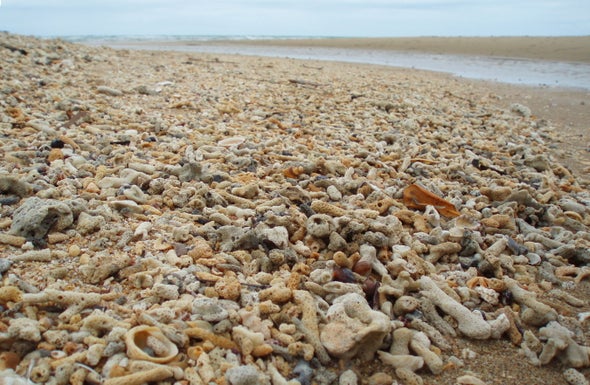(单词翻译:单击)
听力文本
This is Scientific American — 60-Second Science, I'm Christopher Intagliata.
A marine heatwave in 2016 killed off a full third of Australia's Great Barrier Reef, the largest coral reef system in the world.
"It's terrible watching your favorite ecosystems slowly die."
Carly Kenkel is a marine biologist at the University of Southern California who studied that coral bleaching event. Bleaching occurs when the waters around corals become too cold, or too salty, or too hot—but mostly, too hot. And then, the symbiotic algae that live inside corals—which are photosynthetic food factories—abandon the corals. Which causes the corals to die.
"Because they're losing their nutritional source, so they're essentially starving to death."
But coral can house multiple species of algae—some more heat tolerant than others. So sometimes, in the face of stress, the hardier algae proliferate. That change offsets the damage caused by the exodus of the more sensitive species... a process called "shuffling."

Kenkel and her colleagues studied shuffling in corals affected by the 2016 bleaching event, on the Great Barrier Reef. And they found that adult corals can actually pass those reshuffled algal residents along to their offspring, in their eggs—pointing to a possible way successive generations of coral could adapt to warmer waters.
"If your mom can kind of prime you for the environment that you might be experiencing, that presumably would improve your fitness." The details are in the journal Scientific Reports.
So can this help corals beat back bleaching? "The pace of climate change and the frequency and intensity of these stress events is such that I don't think this is enough."
So in the face of so many threats, even this trick may fail to provide relief for the reef.
Thanks for listening for Scientific American — 60-Second Science. I'm Christopher Intagliata.
参考译文
这里是科学美国人——60秒科学系列,我是克里斯托弗·因塔格里塔。
2016年发生的海洋热浪杀死了澳大利亚三分之一的大堡礁,大堡礁是世界上最大的珊瑚礁系统。
“看着自已最喜欢的生态系统慢慢死去非常可怕。”
南加州大学的海洋生物学家卡莉·肯克尔说到,她研究了珊瑚白化事件。当珊瑚周围的海水变得过冷、过咸或过热时,就会发生珊瑚白化现象,不过大多数情况下,珊瑚白化是由海水过热所致。之后,珊瑚礁体内的共生藻类,也就是进行光合作用的食物工厂,会抛弃珊瑚。这会导致珊瑚死亡。
“因为珊瑚失去了营养来源,所以它们基本上会饿死。”
但珊瑚可以容纳多种藻类,其中一些藻类比其他藻类更耐热。因此,有时在面对压力时,耐寒藻类会大量繁殖。这一变化抵消了更敏感物种大批离开所造成的破坏,这一过程被称为“调整”。
肯克尔和同事研究了2016年大堡礁白化事件影响下的珊瑚调整。他们发现,成年珊瑚实际上可以将这些重组的藻类居民传给其卵中的后代,这表明存在一种可能方式,即一代又一代的珊瑚可以适应更温暖的海水。
“如果你妈妈能让你对可能经历的环境有所准备,那可能会提高你的健康水平。”研究详情发表在《科学报告》期刊上。
那这能帮助珊瑚击退白化现象吗?“因为气候变化速度如此之快,这些压力事件的频率和强度又如此之大,所以我认为这不足以击退白化现象。”
因此,面对如此多的威胁,即使是这种方法也可能无法减轻珊瑚礁的压力。
谢谢大家收听科学美国人——60秒科学。我是克里斯托弗·因塔利亚塔。
译文为可可英语翻译,未经授权请勿转载!
重点讲解
重点讲解:
1. kill off 被全部杀死;被灭绝;
Their natural predators have been killed off.
它们的天敌被全部杀死。
2. to death (用于动词后)以致死亡;
He was stabbed to death.
他被刀刺中身亡。
3. in the face of 面对;在…面前;
Little companies are known for their pluck and perseverance, even in the face of a recession.
小公司的勇气和坚毅是出了名的,即使面对经济衰退也是如此。
4. adapt to 适应;
The world will be different, and we will have to be prepared to adapt to the change.
世界会变得不同,我们必须做好准备以适应其变化。


